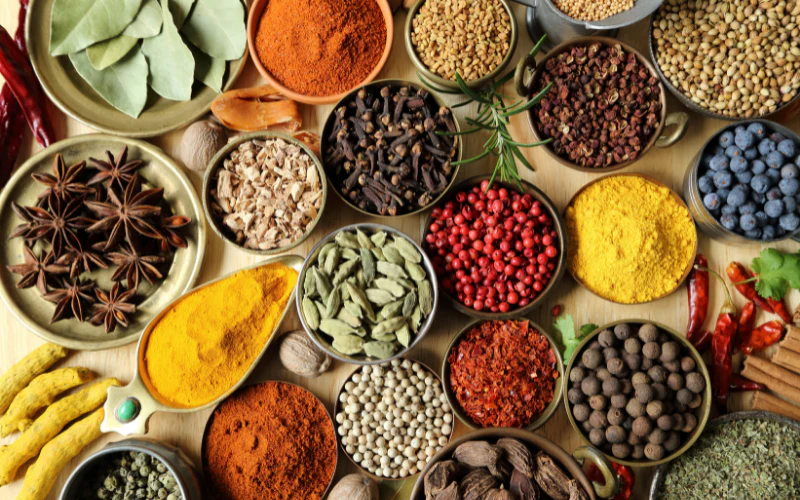The Role of Spices in Shaping India’s Culinary and Trade History

Spices have been an essential part of Indian culture for millennia, influencing not only the nation’s cuisine but also its trade, economy, and global interactions. From ancient times to the modern era, spices have been revered not just for their flavors and aromas, but also for their medicinal and preservative properties. India’s rich and diverse culinary heritage is built on the foundation of these spices, which have woven their way into everyday cooking, ceremonial rituals, and even global trade networks.
The Early Use of Spices in India
India’s association with spices dates back to ancient civilizations. The earliest known use of spices in India can be traced to the Indus Valley Civilization (circa 3300–1300 BCE), where remnants of various spices like mustard, cumin, and sesame have been found. Over time, India became the heart of spice cultivation, with many regions known for specific spices such as black pepper in Kerala, cardamom in the Western Ghats, and saffron in Kashmir.
In Indian culinary traditions, spices are not only used to enhance flavor but also to balance the body’s internal elements, in accordance with the ancient practice of Ayurveda. For centuries, spices have been considered both a culinary necessity and a holistic means of maintaining health, digesting food, and boosting immunity.
The Spice Routes and Trade Networks
India’s strategic location between the East and West made it the center of one of the most important trade routes in the world—the Spice Route. As early as the 3rd century BCE, Indian merchants began trading spices with traders from the Middle East, Southeast Asia, and later Europe. Spices like black pepper, cardamom, cinnamon, turmeric, and ginger became highly sought after, and India quickly became known as the “Spice Bowl” of the world.
The spice trade flourished through various ports along India’s coasts, including those in Kerala, Gujarat, and Tamil Nadu. These spices were not only integral to culinary practices but also prized for their preservative and medicinal qualities. In exchange for spices, India received gold, silver, and other valuable goods from distant lands.
The Colonial Era and the Globalization of Spices
The role of spices in India’s history took a dramatic turn during the colonial period. European powers, particularly the Portuguese, Dutch, French, and British, competed fiercely for control over spice-rich territories. In the late 15th and 16th centuries, the Portuguese established trade routes to India, and Vasco da Gama’s voyage to India opened the doors for European colonialism in the spice trade. The British East India Company also played a significant role in controlling the spice trade and reaping immense wealth from it.
The allure of India’s spices led to the colonization of various parts of the country, with Europeans establishing spice plantations in regions like Kerala and the Malabar Coast. The impact of the spice trade extended beyond economics; it led to cultural exchanges, the blending of culinary traditions, and the introduction of new cooking techniques and flavors across the globe.
Spices and Their Influence on Indian Cuisine
Spices are the cornerstone of Indian cuisine, providing distinct flavors and aromas that make Indian food unique. The intricate use of spices varies from region to region, reflecting India’s cultural diversity. In the north, dishes are often rich and full of flavors like cumin, garam masala, and cardamom. In the south, spices like curry leaves, mustard seeds, and dried red chilies dominate, creating the bold and tangy flavors typical of South Indian cuisine.
The use of spices in Indian food is also deeply rooted in religious and cultural practices. Many festivals and rituals involve the preparation of traditional dishes, where the careful blending of spices is believed to have both spiritual and health benefits. Spices are an integral part of the Indian approach to hospitality, where offering spiced food to guests is seen as an honor.
Spices in Modern-Day India and the Global Market
Today, India remains the world’s largest producer and exporter of spices. The spice industry is a multi-billion-dollar business, with India exporting a wide variety of spices, including chili, turmeric, cumin, and cardamom, to countries around the world. Indian spices have become a staple in kitchens globally, influencing cuisines from Southeast Asia to the Middle East and even Europe.
In addition to their culinary and economic importance, Indian spices continue to shape global perceptions of food and culture. The growing popularity of Indian cuisine worldwide, from spicy curries to flavorful street food, has contributed to the global fascination with Indian spices. Indian spices are now recognized for their health benefits, particularly turmeric, which has gained international acclaim for its anti-inflammatory properties.
The Future of India’s Spice Industry
The future of India’s spice industry looks promising, as the demand for organic and sustainably sourced spices continues to rise. With increasing awareness of the health benefits of natural and traditional ingredients, India’s spices are expected to remain at the forefront of global culinary trends. The Indian government’s efforts to promote spice exports, coupled with initiatives to support small farmers and spice producers, will ensure that India continues to be a dominant force in the global spice market.
Moreover, the rich heritage of India’s spice culture is being preserved and promoted through tourism, with spice plantations and spice tours becoming popular attractions. These initiatives help bridge the gap between traditional spice cultivation and modern culinary practices, fostering a deeper understanding of the country’s spice legacy.
Conclusion
Spices have always been an integral part of India’s culinary identity and have played a central role in shaping its trade and cultural history. From their early use in ancient rituals to their dominance in global trade, spices have been at the heart of India’s connections with the world. Their significance extends beyond food, representing India’s ability to influence global flavors, cultures, and economies. As India continues to navigate the future of its spice industry, the country’s rich spice heritage will remain a testament to its historical and cultural legacy.










